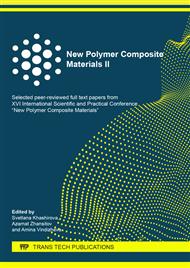[1]
A. Kilyachkov, PVC production in Russia: state and prospects, Plastics. 134 (2014) 42-47.
Google Scholar
[2]
T.N. Khazova, PVC market: scarcity pressure, Plastics. 148 (2015) 14-17.
Google Scholar
[3]
T.N. Khazova, E.B. Cherepova, Status and structure of the Russian polyvinylchloride market, Polymer materials. 1 (2006) 24-31.
Google Scholar
[4]
Guidelines for the development of PVC-based compositions / Edited by R.F. Grossman. Edited from English V.V. Guzeev, Scientific fundamentals and technologies, St.-Petersburg, 2009, pp.34-105.
Google Scholar
[5]
V.G. Nikolaev, Comparative evaluation of modern polyvinyl chloride plastic compounds and halogen-free compositions based on polyolefins, Cables and wires. 324 (2010) 19-26.
Google Scholar
[6]
M.K. Kamensky, The use of polymeric materials at the enterprises of the Association Electrocable,, CABLE-news. 3 (2010) 55-61.
Google Scholar
[7]
Ch. Uilki, J. Samers, Ch. Daniels, Polyvinilchloride, Profession, St. Petersburg, 2007, pp.128-200.
Google Scholar
[8]
R.I. Ableev, Actual problems in the design and manufacture of non-combustible polymer compounds for the cable industry, CABLE-news. 6-7 (2009) 64-69.
Google Scholar
[9]
D.L. Fomin, R.Z. Deberdeev, The effect of aluminum and magnesium hydroxides on the properties of PVC-plasticate, Plastics mass. 12 (2012) 47-50.
Google Scholar
[10]
T.A. Borukaev, R.A. Shetov, A. Kh. Shaov, A.M. Kharaev Thermophysical and Mechanical Properties of PVC and Molybdenum Compounds // Polymer Sci., Series D. 12 (2019) 273-277.
DOI: 10.1134/s1995421219030043
Google Scholar
[11]
I.B. Peshkov, E.I. Uvarov, Trends in the use of certain polymeric materials in the cable industry, Cables and wires. 339 (2013) 3-6.
Google Scholar
[12]
G. Barsamyan, What to add to PVC, Plastics. 90 (2010) 22-25.
Google Scholar
[13]
V.V. Guzeev, Structure and properties of filled polyvinylchloride, Scientific fundamentals and technologies, St. Petersburg, 2012, pp.50-125.
Google Scholar
[14]
V.V. Guzeev, The rational choice of additives for PVC compositions, Polymer materials. 7-8 (2010) 38-48.
Google Scholar


